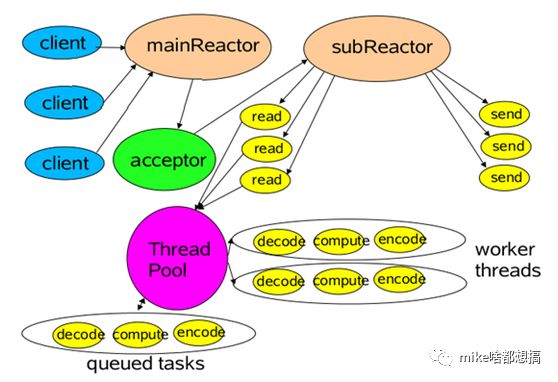netty搭建web聊天室
Posted mike啥都想搞
tags:
篇首语:本文由小常识网(cha138.com)小编为大家整理,主要介绍了netty搭建web聊天室相关的知识,希望对你有一定的参考价值。
之前一直在搞前端的东西,都快忘了自己是个java开发。其实还有好多java方面的东西没搞过,突然了解到netty,觉得有必要学一学。
介绍
Netty是由JBOSS提供的一个java开源框架。Netty提供异步的、事件驱动的网络应用程序框架和工具,用以快速开发高性能、高可靠性的网络服务器和客户端程序。
也就是说,Netty 是一个基于NIO的客户、服务器端编程框架,使用Netty 可以确保你快速和简单的开发出一个网络应用,例如实现了某种协议的客户、服务端应用。Netty相当于简化和流线化了网络应用的编程开发过程,例如:基于TCP和UDP的socket服务开发。
一些IO概念
NIO (non-blocking IO) 非阻塞
BIO (blocking IO) 阻塞
以上两种又可分为同步和异步,即同步阻塞,同步非阻塞,异步阻塞,异步非阻塞。阻塞:数据没来,啥都不做,直到数据来了,才进行下一步的处理。
非阻塞:数据没来,进程就不停的去检测数据,直到数据来。
至于这块的详细概念,大家可以自行百度学习。总之,netty处理io很高效,不需要你担心。
netty结构
可以看出它支持的网络传输协议,以及容器支持,安全支持,io.

工作流程:
所有客户端的连接交给住主线程去管理,响应客户端的消息交给从线程去处理,整个线程池由netty负责。
搭建服务
创建maven工程引入最新的依赖
<project xmlns="http://maven.apache.org/POM/4.0.0" xmlns:xsi="http://www.w3.org/2001/XMLSchema-instance" xsi:schemaLocation="http://maven.apache.org/POM/4.0.0 http://maven.apache.org/xsd/maven-4.0.0.xsd">
<modelVersion>4.0.0</modelVersion>
<groupId>com.mike</groupId>
<artifactId>netty</artifactId>
<version>0.0.1-SNAPSHOT</version>
<properties>
<project.build.sourceEncoding>UTF-8</project.build.sourceEncoding>
<java.version>1.8</java.version>
</properties>
<dependencies>
<dependency>
<groupId>io.netty</groupId>
<artifactId>netty-all</artifactId>
<version>4.1.32.Final</version>
</dependency>
</dependencies></project>创建消息处理器
package netty;import io.netty.buffer.Unpooled;import io.netty.channel.Channel;import io.netty.channel.ChannelHandlerContext;import io.netty.channel.SimpleChannelInboundHandler;import io.netty.channel.group.ChannelGroup;import io.netty.channel.group.DefaultChannelGroup;import io.netty.handler.codec.http.DefaultFullHttpResponse;import io.netty.handler.codec.http.FullHttpRequest;import io.netty.handler.codec.http.FullHttpResponse;import io.netty.handler.codec.http.HttpHeaderValues;import io.netty.handler.codec.http.HttpHeaders;import io.netty.handler.codec.http.HttpResponse;import io.netty.handler.codec.http.HttpResponseStatus;import io.netty.handler.codec.http.HttpVersion;import io.netty.handler.codec.http2.Http2Headers;import io.netty.util.concurrent.GlobalEventExecutor;/** * */public class ChatHandler extends SimpleChannelInboundHandler{
public static ChannelGroup channels = new DefaultChannelGroup(GlobalEventExecutor.INSTANCE);
/** * 每当从服务端收到新的客户端连接时,客户端的 Channel 存入ChannelGroup列表中,并通知列表中的其他客户端 Channel */
@Override
public void handlerAdded(ChannelHandlerContext ctx) throws Exception {
Channel incoming = ctx.channel(); for (Channel channel : channels) {
channel.writeAndFlush("[SERVER] - " + incoming.remoteAddress() + " 加入\n");
}
channels.add(ctx.channel());
}
/** * 每当从服务端收到客户端断开时,客户端的 Channel 移除 ChannelGroup 列表中,并通知列表中的其他客户端 Channel */
@Override
public void handlerRemoved(ChannelHandlerContext ctx) throws Exception {
Channel incoming = ctx.channel(); for (Channel channel : channels) {
channel.writeAndFlush("[SERVER] - " + incoming.remoteAddress() + " 离开\n");
}
channels.remove(ctx.channel());
}
/** * 会话建立时 */
@Override
public void channelActive(ChannelHandlerContext ctx) throws Exception { // (5)
Channel incoming = ctx.channel();
System.out.println("ChatClient:"+incoming.remoteAddress()+"在线");
}
/** * 会话结束时 */
@Override
public void channelInactive(ChannelHandlerContext ctx) throws Exception { // (6)
Channel incoming = ctx.channel();
System.out.println("ChatClient:"+incoming.remoteAddress()+"掉线");
}
/** * 出现异常 */
@Override
public void exceptionCaught(ChannelHandlerContext ctx, Throwable cause) { // (7)
Channel incoming = ctx.channel();
System.out.println("ChatClient:"+incoming.remoteAddress()+"异常"); // 当出现异常就关闭连接
cause.printStackTrace();
ctx.close();
}
/** * 读取客户端发送的消息,并将信息转发给其他客户端的 Channel。 */
@Override
protected void channelRead0(ChannelHandlerContext ctx, Object request) throws Exception {
FullHttpResponse response = new DefaultFullHttpResponse(
HttpVersion.HTTP_1_1,HttpResponseStatus.OK , Unpooled.wrappedBuffer("Hello netty"
.getBytes()));
response.headers().set("Content-Type", "text/plain");
response.headers().set("Content-Length", response.content().readableBytes());
response.headers().set("connection", HttpHeaderValues.KEEP_ALIVE);
ctx.writeAndFlush(response);
}
}这里面其实只需要重写channelRead0 方法就可以了,其他是它的生命周期的方法,可以用来做日至记录。我们在读取消息后,往channel里写入了一个http的response。
初始化我们的消息处理器
package netty;import io.netty.channel.ChannelInitializer;import io.netty.channel.ChannelPipeline;import io.netty.channel.socket.SocketChannel;import io.netty.handler.codec.http.HttpRequestDecoder;import io.netty.handler.codec.http.HttpResponseEncoder;/** * 用来增加多个的处理类到 ChannelPipeline 上,包括编码、解码、SimpleChatServerHandler 等。 */public class ChatServerInitializer extends ChannelInitializer<SocketChannel>{ @Override
protected void initChannel(SocketChannel ch) throws Exception {
ChannelPipeline pipeline = ch.pipeline();
pipeline.addLast("HttpResponseEncoder",new HttpResponseEncoder());
pipeline.addLast("HttpRequestDecoder",new HttpRequestDecoder());
pipeline.addLast("chathandler", new ChatHandler());
System.out.println("ChatClient:"+ch.remoteAddress() +"连接上");
}
}这个pipeline可以理解为netty的拦截器,每个消息进来,经过各个拦截器的处理。我们需要响应http消息,所以加入了响应编码以及请求解码,最后加上了我们的自定义处理器。这里面有很多处理器,netty以及帮你定义好的。
服务启动类
package netty;import io.netty.bootstrap.ServerBootstrap;import io.netty.channel.ChannelFuture;import io.netty.channel.ChannelOption;import io.netty.channel.EventLoopGroup;import io.netty.channel.nio.NioEventLoopGroup;import io.netty.channel.socket.nio.NioserverSocketChannel;/** * The class ChatServer */public class ChatServer { private int port; public ChatServer(int port) { this.port = port;
} public void run() throws Exception {
EventLoopGroup bossGroup = new NioEventLoopGroup();
EventLoopGroup workerGroup = new NioEventLoopGroup(); try {
ServerBootstrap b = new ServerBootstrap();
b.group(bossGroup, workerGroup)
.channel(NioServerSocketChannel.class)
.childHandler(new ChatServerInitializer())
.option(ChannelOption.SO_BACKLOG, 128)
.childOption(ChannelOption.SO_KEEPALIVE, true);
System.out.println("ChatServer 启动了"); // 绑定端口,开始接收进来的连接
ChannelFuture f = b.bind(port).sync(); // (7)
// 等待服务器 socket 关闭 。
// 在这个例子中,这不会发生,但你可以优雅地关闭你的服务器。
f.channel().closeFuture().sync();
} finally {
workerGroup.shutdownGracefully();
bossGroup.shutdownGracefully();
System.out.println("ChatServer 关闭了");
}
} public static void main(String[] args) throws Exception { new ChatServer(8090).run();
}
}这个启动类就是按照上面那个结构图来的,添加两个线程组,设置channel,添加消息处理器,配置一些选项option。
测试
启动程序,浏览器访问 http://localhost:8090

可以在浏览器看到我们返回的消息,但是控制台却显示连接了多个客户端,其实是因为浏览器发送了无关的请求道服务端,由于我们没有做路由,所以所有请求都是200。

可以看到,发送了两次请求。现在我们换postman测试。

这次只有一个客户端连接,当我们关闭postman:
图片描述
客户端显示掉线,整个会话过程结束。
总结
我们完成了服务端的简单搭建,模拟了聊天会话场景。后面再接着完善。
别忘了关注我 mike啥都想搞
mike啥都想搞
以上是关于netty搭建web聊天室的主要内容,如果未能解决你的问题,请参考以下文章
Java+Netty+WebRTC语音视频屏幕共享聊天室设计实践
《Netty+JavaFx实战:仿桌面版微信聊天》代码开源上云部署视频讲解,只为让你给点个Star!